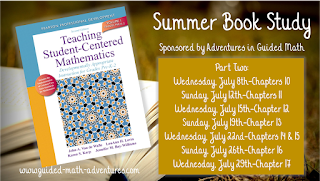I am super excited to be joining my first ever book study Teaching Student-Centered Mathematics by Van de Walle, Lovin, Karp, and Bay-Williams hosted by Adventures in Guided Math.
I am always trying to keep current so when I saw this book recommended by the ladies I decided to purchase and take part! So... here we go!!
Chapter 1: Teaching Mathematics for Understanding
The author opens up the chapter with...
Teachers generally agree that teaching for understanding is a good thing. But this statement begs the question: What is understanding? Understanding is being able to think and act flexibly with a topic or concept. It goes beyond knowing; it is more than a collection of information, facts, or data. It is more than being able to follow steps in a procedure. One hallmark of mathematical understanding is a student's ability to justify why a given mathematical claim or answer is true or why a mathematical rule makes sense (Council of Chief State School Officers, 2010).
Throughout the chapter the author stresses and gives many examples of how students need not just procedural fluency, but conceptual understanding of mathematics as well. As teachers we need to be the ones to expose our students to the many different tools and strategies for solving problems in mathematics. We need to let them explore, learn, and share with their peers while providing direct instruction when necessary. Letting our students thinking, discussions, failures, and successes guide the learning can be a little scary at first, but just may lead to some amazing mathematical understanding!
Chapter 2: Teaching Mathematics through Problem Solving
The focus on chapter 2 is how to teach through problem solving not just to teach for problem solving. The author stresses the fact that teaching through problem solving helps children develop relational understanding. Problem solving is completely interwoven with learning. The easiest way to explain the difference is that when you teach for problem solving you teach a specific skill, give time to practice the specific skill, and then use the specific skill to help solve a problem. When you teach through problem solving you start with the specific problem(task or activity) itself. Since the teacher is creating the problem specifically for their students it allows them to learn new mathematical concepts as well as connect/create relationships to previous learned concepts.
There are 3 common features problems need to have to be effective:
- The problem should engage children where they are in their current understanding.
- The problematic or engaging aspect of the problem must be a result of the mathematics that the children are to learn.
- The problem must require justifications and explanations for answers and methods.
There are many examples given on the types of problems you can use to teach through problem solving. The author stated that when beginning a lesson with a problem it gets children excited about learning about mathematics. We need to design problems that provide specific parameters, constraints, or structure that will support the development of the mathematical ideas that we want children to learn.
The value of student discussion was a key factor in problem solving. We need to remember to:
- Clarify children's ideas in a variety of ways
- Emphasize reasoning
- Encourage student-student dialogue
When I think about my own students learning I remember that the best lessons were when they were discussing ways to handle a problem, sharing the way the solved tasks, or politely agreeing or disagreeing with each other. As a teacher this was a proud moment to see them take charge, be successful, and truly understand.
There were so many valuable things in chapter 2. If you do not have a copy of Teaching Student-Centered Mathematics, I recommend you get yourself a copy. Come join us for on Wednesday for as we explore the next two chapters!!





Thanks so much for participating in the book study! You will have a unique perspective as we read on since you have looped with your students. Thanks for sharing your thoughts and for reflecting back on your experiences with your students. Looking forward to the next two chapters... :0)
ReplyDeleteSmiles,
Sarah